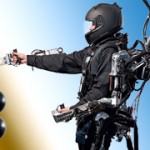Archive for Май, 2008
Костюм Raytheon умножает силу человека в 20 раз
- Тип контента: Новостная статья
- Номер документа: 2084
- Название документа: Костюм Raytheon умножает силу человека в 20 раз
- Номер (DOI, IBSN, Патент): Не заполнено
- Изобретатель/автор: Не заполнено
- Правопреемник/учебное заведение: Не заполнено
- Дата публикации документа: 2008-05-26
- Страна опубликовавшая документ: Россия
- Язык документа: Русский
- Наименование изделия: Не заполнено
- Источник: http://www.membrana.ru/particle/3272
- Вложения: Не заполнено
- Аналитик: Ридна Украина)))
 США. Штат Юта. Солт-Лейк-Сити. Исследовательская лаборатория компании Raytheon. Здесь идет работа над одним из самых грандиозных изобретений — костюмом, наделяющим человека мощью боевого робота. Долгое время это был один из наиболее впечатляющих научно-фантастических образов. Но скоро такая разработка войдёт в реальную жизнь. Впрочем, уже почти вошла…
США. Штат Юта. Солт-Лейк-Сити. Исследовательская лаборатория компании Raytheon. Здесь идет работа над одним из самых грандиозных изобретений — костюмом, наделяющим человека мощью боевого робота. Долгое время это был один из наиболее впечатляющих научно-фантастических образов. Но скоро такая разработка войдёт в реальную жизнь. Впрочем, уже почти вошла…
Категория: XOS 1 | Нет комментариев »
Electromyography sensor based control for a hand exoskeleton
- Тип контента: Научная статья
- Номер документа: 508
- Название документа: Electromyography sensor based control for a hand exoskeleton
- Номер (DOI, IBSN, Патент): 10.1109/ROBIO.2007.4522381
- Изобретатель/автор: Zimmermann, A, Wege, A.
- Правопреемник/учебное заведение: Real-Time Syst. & Robot. Tech., Univ. Berlin, Berlin
- Дата публикации документа: 2008-05-16
- Страна опубликовавшая документ: Германия
- Язык документа: Английский
- Наименование изделия: Не заполнено
- Источник: http://ieeexplore.ieee.org/search/freesrchabstract.jsp?tp=&a
- Вложения: Да
- Аналитик: Дмитрий Соловьев
 This paper presents a electromyography (EMG) control for a hand exoskeleton. The device was developed with focus on support of the rehabilitation process after hand injuries or strokes. As the device is designed for the later use on patients, which have limited hand mobility, fast undesired movements have to be averted. Safety precautions in the hardware and software design of the system must be taken to ensure this. The construction allows controlling the motion of finger joints. However, due to friction in gears and mechanical construction it is not possible to move finger joints within the construction without help of actuators. Therefore force sensors are integrated into the construction to measure force exchanged between human and exoskeleton. These allow the human to control the movements of the hand exoskeleton which is useful to teach new trajectories, for muscle training, or for diagnostic purposes. The control method using electromyography (EMG) sensor presented in this paper uses the EMG sensor values to generate a trajectory, which is executed by a position control loop based on sliding mode control.
This paper presents a electromyography (EMG) control for a hand exoskeleton. The device was developed with focus on support of the rehabilitation process after hand injuries or strokes. As the device is designed for the later use on patients, which have limited hand mobility, fast undesired movements have to be averted. Safety precautions in the hardware and software design of the system must be taken to ensure this. The construction allows controlling the motion of finger joints. However, due to friction in gears and mechanical construction it is not possible to move finger joints within the construction without help of actuators. Therefore force sensors are integrated into the construction to measure force exchanged between human and exoskeleton. These allow the human to control the movements of the hand exoskeleton which is useful to teach new trajectories, for muscle training, or for diagnostic purposes. The control method using electromyography (EMG) sensor presented in this paper uses the EMG sensor values to generate a trajectory, which is executed by a position control loop based on sliding mode control.
Категория: Научные статьи | Нет комментариев »
Боевые нанотехнологии. Обзор разработок.
- Тип контента: Новостная статья
- Номер документа: 4494
- Название документа: Боевые нанотехнологии. Обзор разработок.
- Номер (DOI, IBSN, Патент): Не заполнено
- Изобретатель/автор: Не заполнено
- Правопреемник/учебное заведение: Не заполнено
- Дата публикации документа: 2008-05-16
- Страна опубликовавшая документ: Россия
- Язык документа: Русский
- Наименование изделия: Не заполнено
- Источник: http://lenta.ru/articles/2008/05/16/nano/
- Вложения: Не заполнено
- Аналитик: Helix
 Разработка нанотехнологий во всем мире приобретает все более военизированный характер.В последнее время тема нанотехнологий становится все более популярной в зарубежных и отечественных СМИ.
Разработка нанотехнологий во всем мире приобретает все более военизированный характер.В последнее время тема нанотехнологий становится все более популярной в зарубежных и отечественных СМИ.
Категория: Продвижение | Нет комментариев »
Fundamentals of Ergonomic Exoskeleton Robots
- Тип контента: Обзор технологии
- Номер документа: 8073
- Название документа: Fundamentals of Ergonomic Exoskeleton Robots
- Номер (DOI, IBSN, Патент): Не заполнено
- Изобретатель/автор: André Schiele
- Правопреемник/учебное заведение: University of Applied Sciences Kaiserslautern
- Дата публикации документа: 2008-05-14
- Страна опубликовавшая документ: Германия
- Язык документа: Английский
- Наименование изделия: Не заполнено
- Источник: Не заполнено
- Вложения: Да
- Аналитик: Глаголева Елена
 With this thesis, I would like to lay the foundations for designing human interfacing wearable exoskeleton robots that are truly designed for the human. Before starting the development of the first human arm exoskeleton prototype, tasked to telemanipulate a space robot, I extensively searched for prior art in databases to potentially find guidelines on how to design a wearable robotic exoskeleton. Information was very scarce, however, and I found only a handful of information at all. Previous records have either shown device concepts only, incomplete devices or devices built to interact with only a sub-set of joints of the human arm. No record has provided evidence of a successful robot control with a portable exoskeleton, let alone with force-feedback to the operator. Not even to speak of finding quantitative analyses about the goodness of physical human–robot interaction or about bilateral control performance with such exoskeletons. Most of the reference material rather raised new questions than providing answers to me. I noticed that previous exoskeleton devices had been designed similar to typical robotic manipulators, but aiming to encapsulate the human limb. This was done despite the fact that artificial robotic systems are fundamentally different in structure from biological human limbs. Moreover, all prior exoskeletons had been developed with anthropometric data of specific indivi-duals. This seemed like a wrong approach to me and inspired me to investigate how these fundamental differences between robots and humans can be harmonized. I was motivated to start this scientific research about finding the fundamentals of ergonomic exoskeleton design. Now, a couple of years later, I can present with this thesis a novel quantitative analysis approach for assessing combined physical human–exoskeleton interaction. The theory presented allows the design analysis and evaluation of exoskeletons, and the solutions provided offer a clear set of design guidelines helpful to the community in the future. The guidelines show, on scientific grounds, how to best conceive exoskeleton kinematics, motorization and mechanical structures for enabling smooth and comfortable physical human robot interaction with portable exoskeletons. Technological solutions are proposed as well, that allow conceiving of lightweight exoskeletons with little apparent inertia and good force-feedback performance for robotic telemanipulation. The feasibility of developing a portable and body-grounded exoskeleton for the entire human arm is shown for the first time. It is proven that the device can interact seamlessly with natural motion of the human arm, without variation of its mechanical structure, for different operators. A new paradigm for the design of kinematic exoskeleton structures is developed, as well as a novel actuator concept, based on Bowden Cable transmissions. The results presented in this thesis provide the lacking theoretical fundament and the technological solutions, which together enable the design of physically interacting human–robot systems that are truly conceived for the human.
With this thesis, I would like to lay the foundations for designing human interfacing wearable exoskeleton robots that are truly designed for the human. Before starting the development of the first human arm exoskeleton prototype, tasked to telemanipulate a space robot, I extensively searched for prior art in databases to potentially find guidelines on how to design a wearable robotic exoskeleton. Information was very scarce, however, and I found only a handful of information at all. Previous records have either shown device concepts only, incomplete devices or devices built to interact with only a sub-set of joints of the human arm. No record has provided evidence of a successful robot control with a portable exoskeleton, let alone with force-feedback to the operator. Not even to speak of finding quantitative analyses about the goodness of physical human–robot interaction or about bilateral control performance with such exoskeletons. Most of the reference material rather raised new questions than providing answers to me. I noticed that previous exoskeleton devices had been designed similar to typical robotic manipulators, but aiming to encapsulate the human limb. This was done despite the fact that artificial robotic systems are fundamentally different in structure from biological human limbs. Moreover, all prior exoskeletons had been developed with anthropometric data of specific indivi-duals. This seemed like a wrong approach to me and inspired me to investigate how these fundamental differences between robots and humans can be harmonized. I was motivated to start this scientific research about finding the fundamentals of ergonomic exoskeleton design. Now, a couple of years later, I can present with this thesis a novel quantitative analysis approach for assessing combined physical human–exoskeleton interaction. The theory presented allows the design analysis and evaluation of exoskeletons, and the solutions provided offer a clear set of design guidelines helpful to the community in the future. The guidelines show, on scientific grounds, how to best conceive exoskeleton kinematics, motorization and mechanical structures for enabling smooth and comfortable physical human robot interaction with portable exoskeletons. Technological solutions are proposed as well, that allow conceiving of lightweight exoskeletons with little apparent inertia and good force-feedback performance for robotic telemanipulation. The feasibility of developing a portable and body-grounded exoskeleton for the entire human arm is shown for the first time. It is proven that the device can interact seamlessly with natural motion of the human arm, without variation of its mechanical structure, for different operators. A new paradigm for the design of kinematic exoskeleton structures is developed, as well as a novel actuator concept, based on Bowden Cable transmissions. The results presented in this thesis provide the lacking theoretical fundament and the technological solutions, which together enable the design of physically interacting human–robot systems that are truly conceived for the human.
Категория: Подборки книг | Нет комментариев »
Mechanical design and motion control of a hand exoskeleton for rehabilitation
- Тип контента: Научная статья
- Номер документа: 698
- Название документа: Mechanical design and motion control of a hand exoskeleton for rehabilitation
- Номер (DOI, IBSN, Патент): 10.1109/ICMA.2005.1626539
- Изобретатель/автор: Wege, A., Kondak, K., Hommel, G.
- Правопреемник/учебное заведение: Real-Time Syst. & Robotics, Tech. Univ. Berlin, Germany
- Дата публикации документа: 2008-05-08
- Страна опубликовавшая документ: Германия
- Язык документа: Английский
- Наименование изделия: Не заполнено
- Источник: http://ieeexplore.ieee.org/search/freesrchabstract.jsp?tp=&a
- Вложения: Да
- Аналитик: Дмитрий Соловьев
 Hand injuries are a frequent problem. The great amount of hand injuries is not only a problem for the affected people but economic consequences follow because rehabilitation takes a long time. To improve therapy results and reduce cost of rehabilitation a handexoskeleton was developed. For research on control algorithms and rehabilitation programs a prototype supporting all four degrees of freedom of one finger was built (s. Fig. 1). In view of the fact that a lot of hand injuries affect only one finger, this prototype could already be functional in physical therapy. A robust sliding mode controller was proposed for motion control of the handexoskeleton. The performance of the controller was evaluated for step response. In a second experiment varied forces where applied during the sensor was set to hold a constant position. Finally the controller was set to follow a complete trajectory.
Hand injuries are a frequent problem. The great amount of hand injuries is not only a problem for the affected people but economic consequences follow because rehabilitation takes a long time. To improve therapy results and reduce cost of rehabilitation a handexoskeleton was developed. For research on control algorithms and rehabilitation programs a prototype supporting all four degrees of freedom of one finger was built (s. Fig. 1). In view of the fact that a lot of hand injuries affect only one finger, this prototype could already be functional in physical therapy. A robust sliding mode controller was proposed for motion control of the handexoskeleton. The performance of the controller was evaluated for step response. In a second experiment varied forces where applied during the sensor was set to hold a constant position. Finally the controller was set to follow a complete trajectory.
Категория: Научные статьи | Нет комментариев »
Статистика
Категорий: 179
Статей всего: 2,003
По типу:
Видео: 36
Выдержка с форума: 1
Контактные данные: 12
Научная статья: 1388
Не заполнено: 5
Новостная статья: 317
Обзор технологии: 42
Патент: 219
Тех.подробности: 34
Тип: 1
Комментариев: 9,332
Изображений: 3,005
Подробней...
ТОР 10 аналитиков
-
Глаголева Елена - 591
Дмитрий Соловьев - 459
Helix - 218
Ридна Украина))) - 85
Наталья Черкасова - 81
max-orduan - 29
Елена Токай - 15
Роман Михайлов - 9
Мансур Жигануров - 4
Дуванова Татьяна - 3
Календарь
Авторизация
Ошибка в тексте?
Выдели её мышкой!
И нажми Ctrl+Enter